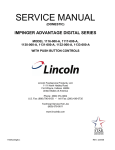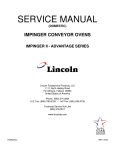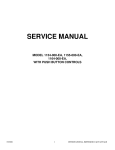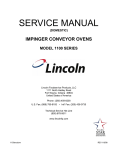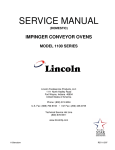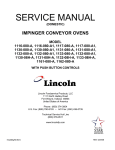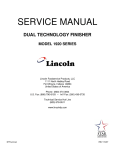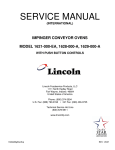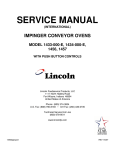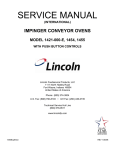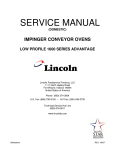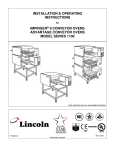Download Lincoln 1154-000-EA User's Manual
Transcript
SERVICE MANUAL (INTERNATIONAL) IMPINGER ADVANTAGE DIGITAL SERIES MODEL 1154-000-EA, 1155-000-EA, 1164-000-EA WITH PUSH BUTTON CONTROLS Lincoln Foodservice Products, LLC 1111 North Hadley Road Fort Wayne, Indiana 46804 United States of America Phone : (800) 374-3004 U.S. Fax: (888) 790-8193 • Int’l Fax: (260) 436-0735 Technical Service Hot Line (800) 678-9511 www.lincolnfp.com 1100ExAdDig REV: 11/8/07 SEQUENCE OF OPERATIONS IMPINGER II ADVANTAGE SERIAL NUMBER 2038616 AND ABOVE (OVENS WITH PUSH BUTTON CONTROLS) MODEL 1154-000-EA MODEL 1155-000-EA POWER SUPPLY CONTROL BOX AUTO COOL DOWN MAIN FAN CIRCUIT BURNER CIRCUIT IGNITION CONTROL TEMPERATURE CONTROL CONVEYOR DRIVE 2 NAT. GAS LP GAS 230VAC 230VAC 50 HZ. 50 HZ. 1 PHASE 1 PHASE Electrical power to be supplied to the oven by a three conductor service. When the temperature in the control box reaches 120°F ± 3°F (48.9°C ± 1.7°C), the cooling fan thermostat will switch power to the control box cooling fan. The thermostat will interrupt power to the cooling fan when the control box temperature falls to 100°F ± 3°F (37.8°C ± 1.7°C). Power is permanently supplied, through a 10 amp oven fuse, through a normally closed control box hi-limit thermostat (opens at 140°F, 60°C), to the normally open double pole oven fan switch and to the cooling fan. Closing the oven fan switch supplies line voltage to the main fan motor. Closing the main fan switch also supplies voltage to the cooling fan, the primary of the control transformer, the conveyor motor, and the burner system. Closing the oven fan switch supplies line voltage through the normally open gas pressure switch (located in the gas valve and closed when gas pressure is present), through the normally open air pressure switch (closed by the air pressure from the main fan), through the normally closed oven cavity hi-limit thermostat (opens at 662°F, 350°C), and to the ignition control. The ignition control switches line voltage to the combustion blower motor. The combustion air pressure switch switches from normally closed to normally open upon sensing air pressure in the burner housing. After a pre-purge period of between 30 and 60 seconds, the spark generator is energized, the main gas valve and the burner pilot light are energized, and ignition should now occur. Closing the oven fan switch supplies line voltage to the primary of the control transformer. Secondary voltage, 24VAC, is supplied to the oven control. The oven control is set to desired temperature. The thermocouple will provide varying millivolts to the oven control. The oven control supplies line voltage to the temperature regulation valve at intermittent intervals to maintain the desired temperature. The display on the oven control will indicate when the temperature regulation valve is energized. NOTE: The display also indicates oven temperature. Closing the oven fan switch supplies line voltage to the conveyor motor and to the primary of the control transformer. Secondary voltage, 24VAC, is supplied to the oven control. Setting the oven control to the desired time outputs voltage, through a reversing switch, to the conveyor motor. NOTE: The conveyor system uses a hall effect sensor and magnet to prove operation of the conveyor motor. If the conveyor motor is not running, “BELT JAM” is indicated on the display. Impinger II – Advantage Digital Service Manual - International SEQUENCE OF OPERATIONS IMPINGER II ADVANTAGE SERIAL NUMBER 2038616 AND ABOVE (OVENS WITH PUSH BUTTON CONTROLS) MODEL 1164-000-EA POWER SUPPLY MAIN FAN CIRCUIT HEAT CIRCUIT CONVEYOR CONTROL 400/230VAC 50HZ. 3 PHASE Electrical power to be supplied to the oven by a four conductor service. Brown conductor is hot. Black conductor is hot. Black conductor is hot. Green conductor is ground. Power is permanently supplied, through the 10 amp oven fuse, through the normally closed control box hi-limit thermostat (opens at 140°F, 60°C), to the normally open oven fan switch. Power is also supplied to the normally open cooling fan thermostat. Closing the oven fan switch supplies line voltage to the main fan motor, the cooling fan, the primary of the control transformer and to the oven control. Closing the oven fan switch supplies line voltage, through the normally open air pressure switch (closed by air pressure from the main fan) to the oven control. Line voltage is also supplied to the primary of the control transformer. Secondary voltage, 24VAC, is supplied to the oven control. The oven control is set to desired temperature. The thermocouple will provide varying millivolts to the oven control. The oven control supplies line voltage to the coil of the contactor at intermittent intervals to maintain the desired temperature. The display on the oven control will indicate when the contactor is energized. NOTE: The display also indicates oven temperature. Closing the oven fan switch supplies line voltage to the conveyor motor and to the primary of the control transformer. Secondary voltage, 24VAC, is supplied to the oven control. Setting the oven control to the desired time outputs voltage, through a reversing switch, to the conveyor motor. NOTE: The conveyor system uses a hall effect sensor and magnet to prove operation of the conveyor motor. If the conveyor motor is not running, “BELT JAM” is indicated on the display. Impinger II – Advantage Digital Service Manual - International 3 SCHEMATIC DIAGRAM MODEL 1154-000-EA, 1155-000-EA SERIAL NUMBER 2038616 TO 2045407 4 Impinger II – Advantage Digital Service Manual - International SCHEMATIC DIAGRAM MODEL 1154-000-EA, 1155-000-EA SERIAL NUMBER 2045408 AND ABOVE Impinger II – Advantage Digital Service Manual - International 5 SCHEMATIC DIAGRAM MODEL 1164-000-EA SERIAL NUMBER 2038616 AND ABOVE 6 Impinger II – Advantage Digital Service Manual - International SCHEMATIC DIAGRAM MODEL 1164-000-EA SERIAL NUMBER 2053336 AND ABOVE (RoHS Compliant) Impinger II – Advantage Digital Service Manual - International 7 TROUBLESHOOTING GUIDE IMPINGER II ADVANTAGE SERIAL NUMBER 2038616 AND ABOVE (OVENS WITH PUSH BUTTON CONTROLS) MODEL 1154-000-EA MODEL 1155-000-EA NAT. GAS LP GAS 230VAC 230VAC 50 HZ. 50 HZ. 1 PHASE 1 PHASE REFER TO PROPER SCHEMATIC FOR IDENTIFIED COMPONENTS SYMPTOM Oven fan will not run POSSIBLE CAUSE Incoming power supply Fuse, 10 amp Fuse holder Hi-limit thermostat, control box Switch, main fan Motor, main fan Capacitor No control box cooling Incoming power supply Switch, main fan Cooling fan No automatic control box cooling Incoming power supply Cooling fan thermostat Cooling fan Oven will not heat Serial Number 2045407 & Below Gas supply Main fan Gas pressure switch 8 EVALUATION Check breaker, reset if required. Check power plug to be sure it is firmly in receptacle. Measure incoming power, call power co. if needed. Check, replace if necessary. Check, replace if necessary. Check for voltage on both sides of switch. Terminals are normally closed. If open, reset and test oven for proper operation. If thermostat will not hold, and control box temperature is not exceeding 140°F (60°C), replace thermostat. With power off, check continuity between switch terminals. Replace as needed. Check for opens, shorts or grounds. With power off, turn fan blade to check for locked rotor. Check for shorts or grounds. WARNING: Capacitor has a stored charge, discharge before testing. Check breaker, reset if required. Check power plug to be sure it is firmly in receptacle. Measure incoming power, call power co. if needed. With power off, check continuity between switch terminals. Replace as needed. Line voltage should now be at the cooling fan. If voltage is present, check motor for opens, shorts or grounds. With power off, check for locked rotor. Check breaker, reset if required. Check power plug to be sure it is firmly in receptacle. Measure incoming power, call power co. if needed. Check the cooling fan thermostat (thermostat closes at 120°F and opens at 100°F). With the cooling fan thermostat pre-heated, check for continuity. If thermostat is open, replace cooling fan thermostat. Line voltage should now be at the cooling fan. If voltage is present, check motor for opens, shorts or grounds. With power off, check for locked rotor. Check for adequate gas supply and be sure that the manual gas shut off valve is open. Also check flexible gas line connection. If not operating, refer to “Oven fan will not run”. This switch is located inside the gas valve and should close when gas pressure is present. WITH POWER OFF: Remove 3 prong plug (on gas valve) and measure continuity between terminals 2 and 3. If no continuity, check the following: Proper gas pressure supply to gas valve as marked on the oven specification plate. Check for proper adjustment of the gas pressure switch, 10 for Nat. gas, 27 for LP gas or 4.5 for town gas. Check the filter in gas valve for Impinger II – Advantage Digital Service Manual - International Air pressure switch Oven cavity hi-limit thermostat Ignition control Burner blower motor Air pressure switch (burner blower) Spark generator Igniter/sensor assembly Gas valve Flame will not stay on Flame sensor Impinger II – Advantage Digital Service Manual - International blockage or damage. If above checks are okay, but pressure switch is still not closed, replace gas valve. Check air switch terminals for supply voltage to terminals NO2 and COM. If voltage is present on one side only, check for air tube blockage or misalignment. If these are okay, adjust air pressure switch or replace if necessary. Terminals are normally closed, opens at 660°F (350°C). If open, reset and test oven for proper operation. If thermostat will not hold for maximum oven temperature, and oven is not exceeding control setting, check for proper location of capillary bulb in its spring holder. If above checks are okay, replace hi-limit thermostat. Check for proper supply voltage to ignition control. Check for proper voltage to the burner blower motor. This can be checked at motor connecting plug terminals 2 and 5. If voltage is present, proceed with next step, if not, wait 30 seconds, push reset button and try to restart. If this fails, check wires from thermostat and burner blower motor to the ignition control. If the above checks okay, replace ignition control. Check for supply voltage to motor. WITH POWER OFF: Turn blower wheel to check for locked rotor. If supply voltage is present at motor connecting plug terminals 2 and 5, and motor does not run, replace burner blower motor. Check for proper supply voltage switching from “NC” to “NO” on ignition control. Check for air pressure switch adjustment, air tube blockage or misalignment. If these adjustments fail, replace air pressure switch. A pre-purge time of 30 to 60 seconds occurs after burner blower motor starts. Check for supply voltage at spark generator. If voltage is not present, check reset button for ignition control. If voltage is still not present, replace ignition control. If there is input voltage to the spark generator, but there is no high voltage output, replace the spark generator. Check this assembly for visible damage. Replace as needed. If there is no visible damage, check for voltage supply to igniter/sensor assembly. If there is voltage supplied to the igniter/sensor, but there is no spark, replace igniter/sensor assembly. Gas valve should open when proper supply voltage is present. If there is no voltage present, check reset button on ignition control, and all connections for tightness. If there is still no voltage to gas valve, replace the ignition control. If there is voltage to the gas valve, check for gas pressure at the gas pressure tap (located in the gas piping just prior to the burner). If there is no gas pressure, replace the gas valve. To check for flame sensor operation, connect a digital multimeter (capable of measuring DC microamps) between the flame sensor wire and terminal #1 on the ignition control. Sensor current is to be 3 microamps, minimum. If these readings are not achieved, replace igniter/sensor assembly. Also check for any type of damage to flame sensor wire and connections. NOTE: The DC microamp test must be conducted with the oven in low flame (bypass) operation. 9 Power supply Ignition control Oven will not heat Serial Number 2045408 & Above Gas supply Main fan Air pressure switch Oven cavity hi-limit thermostat Ignition control Burner blower motor Air pressure switch (burner blower) Ignition control Igniter/sensor assembly Gas valve 10 Set the temperature to the lowest temperature setting. If there is sufficient microamp current, but the flame will not stay lit, check for proper polarity of the power supply. If there is sufficient microamp current, and there is proper polarity of the power supply, but the burner will not stay lit, check the reset button on the ignition control. If the above test is okay, replace the ignition control. Check for adequate gas supply and be sure that the manual gas shut off valve is open. Also check flexible gas line connection. If not operating, refer to “Oven fan will not run”. Check air switch terminals for supply voltage to terminals C and NO. If voltage is present on one side only, check for air tube blockage or misalignment. If these are okay, adjust air pressure switch or replace if necessary. Terminals are normally closed, opens at 350°C (660°F). If open, reset and test oven for proper operation. If thermostat will not hold for maximum oven temperature, and oven is not exceeding control setting, check for proper location of capillary bulb in its spring holder. If above checks are okay, replace hi-limit thermostat. Check for proper supply voltage to ignition control. Check for proper voltage to the burner blower motor. This can be checked at motor connecting plug terminal 5 and Neutral. If voltage is present, proceed with next step, if not, wait 30 seconds, push reset button and try to restart. If this fails, check wires from burner blower motor to the ignition control. If the above checks okay, replace ignition control. Check for supply voltage to motor. WITH POWER OFF: Turn blower wheel to check for locked rotor. If supply voltage is present at motor connecting plug terminal 5 and Neutral, and motor does not run, replace burner blower motor. Check for proper supply voltage switching from “NC” to “NO” on ignition control. Check for air pressure switch adjustment, air tube blockage or misalignment. If these adjustments fail, replace air pressure switch. A pre-purge time of 30 to 60 seconds occurs after burner blower motor starts. Check for high voltage spark output from the ignition control. If there is no high voltage spark output, check reset button for ignition control. If there is still no high voltage output, replace the ignition control. Check this assembly for visible damage. Replace as needed. If there is no visible damage, check for voltage supply to igniter/sensor assembly. If there is voltage supplied to the igniter/sensor, but there is no spark, replace igniter/sensor assembly. Gas valve should open as the ignition control generates the high voltage spark. Place manometer on the pressure tap fitting (located in the gas piping just prior to the burner manifold) and check for gas pressure. If valve does not open, check reset button on ignition control, and all connections for tightness. If there is still no gas pressure, remove the ignition control from the gas valve. Check the coils of the gas valve for opens or Impinger II – Advantage Digital Service Manual - International Flame will not stay on Flame sensor Power supply Ignition control Low flame is on, but no main flame NOTE: Flame should be on at this time Control transformer Conveyor motor Capacitor, conveyor motor Switch, conveyor reversing Oven control Conveyor motor runs, but there is no speed display shorts. Readings should be as follows, V1 – 2.9K ohms approx., V2 – 1.3K ohms approx. If these readings are not achieved, replace gas valve. If these readings are achieved, replace ignition control. To check for flame sensor operation, connect a digital multimeter (capable of measuring DC microamps) between the flame sensor wire and the flame sensor connection on the ignition control. Sensor current is to be 0.9 microamps, minimum. If these readings are not achieved, replace igniter/sensor assembly. Also check for any type of damage to flame sensor wire and connections. NOTE: The DC microamp test must be conducted with the oven in low flame (bypass) operation. Set the temperature to the lowest temperature setting. If there is sufficient microamp current, but the flame will not stay lit, check for proper polarity of the power supply. If there is sufficient microamp current, and there is proper polarity of the power supply, but the burner will not stay lit, check the reset button on the ignition control. If the above test is okay, replace the ignition control. Check for supply voltage to the primary of control transformer. If no voltage is present, trace wiring back to oven fan switch. If voltage is present, check for 24VAC at transformer secondary. If there is primary voltage, but no secondary voltage, replace control transformer. Check for supply voltage to the conveyor motor at terminal #6 to neutral. If no voltage is present, trace wiring back to the oven fan switch. If voltage is present, but the motor will not run, check the motor windings for opens or shorts. If any of the above fail, replace the conveyor motor. Check for shorts or grounds. Replace capacitor as needed. WARNING: Capacitor has a stored charge, discharge before testing. Check continuity between switch terminals. Replace switch as needed. If there is voltage supplied to the motor, and the motor, capacitor and reversing switch check good, replace the oven control. NOTE: Display will indicate “BELT JAM” Oven control Conveyor motor Impinger II – Advantage Digital Service Manual - International Check for output voltage from oven control to hall effect sensor (sensor is located in the conveyor motor). Measure voltage at the motor connector, red wire and yellow wire. Voltage should be approx. 10VDC. If no voltage is present, trace wiring back to oven control. If there is no voltage output at the oven control, replace oven control. If there is voltage supplied to the hall effect sensor, check for a frequency output from the hall effect sensor. Measure frequency across the yellow and white wires in the motor connector. Frequency reading 11 should be approx. 25-100 Hz. If these readings are not achieved, replace conveyor motor. If the readings are achieved, proceed. If the hall effect sensor readings are correct, but there is no speed indicated on the display, replace the oven control Oven control TROUBLESHOOTING GUIDE IMPINGER II ADVANTAGE SERIAL NUMBER 2038616 AND ABOVE (OVENS WITH PUSH BUTTON CONTROLS) MODEL 1164-000-EA 400/230VAC 50HZ. 3 PHASE REFER TO PROPER SCHEMATIC FOR IDENTIFIED COMPONENTS SYMPTOM Oven fan will not run POSSIBLE CAUSE Incoming power supply Oven cavity hi-limit thermostat Fuse, 10 amp Fuse holder Hi-limit thermostat, control box Switch, main fan Motor, main fan Capacitor No control box cooling Incoming power supply Oven cavity hi-limit thermostat Fuse, 10 amp Fuse holder Hi-limit thermostat, control box Switch, main fan 12 EVALUATION Check breaker, reset if required. Check power plug to be sure it is firmly in receptacle. Measure incoming power, call power co. if needed. Terminals are normally closed, opens at 660°F (350°C). If open, reset and test oven for proper operation. If thermostat will not hold for maximum oven temperature, and oven is not exceeding control setting, check for proper location of capillary bulb ion its spring holder. If above checks are okay, replace hi-limit thermostat. Check, replace if necessary. Check, replace if necessary. Check for voltage on both sides of switch. Terminals are normally closed. If open, reset and test oven for proper operation. If thermostat will not hold, and control box temperature is not exceeding 140°F (60°C), replace thermostat. With power off, check continuity between switch terminals. Replace as needed. Check for opens, shorts or grounds. With power off, turn fan blade to check for locked rotor. Check for shorts or grounds. WARNING: Capacitor has a stored charge, discharge before testing. Check breaker, reset if required. Check power plug to be sure it is firmly in receptacle. Measure incoming power, call power co. if needed. Terminals are normally closed, opens at 660°F (350°C). If open, reset and test oven for proper operation. If thermostat will not hold for maximum oven temperature, and oven is not exceeding control setting, check for proper location of capillary bulb in its spring holder. If above checks are okay, replace hi-limit thermostat. Check, replace if necessary. Check, replace if necessary. Check for voltage on both sides of switch. Terminals are normally closed. If open, reset and test oven for proper operation. If thermostat will not hold, and control box temperature is not exceeding 140°F (60°C), replace thermostat. With power off, check continuity between switch Impinger II – Advantage Digital Service Manual - International Cooling fan No automatic control box cooling Incoming power supply Oven cavity hi-limit thermostat Fuse, 10 amp Fuse holder Hi-limit thermostat, control box Cooling fan thermostat Cooling fan Oven will not heat Main fan Control transformer Air pressure switch Oven control Thermocouple Impinger II – Advantage Digital Service Manual - International terminals. Replace as needed. Line voltage should now be at the cooling fan. If voltage is present, check motor for opens, shorts or grounds. With power off, check for locked rotor. Check breaker, reset if required. Check power plug to be sure it is firmly in receptacle. Measure incoming power, call power co. if needed. Terminals are normally closed, opens at 660°F (350°C). If open, reset and test oven for proper operation. If thermostat will not hold for maximum oven temperature, and oven is not exceeding control setting, check for proper location of capillary bulb ion its spring holder. If above checks are okay, replace hi-limit thermostat. Check, replace if necessary. Check, replace if necessary. Check for voltage on both sides of switch. Terminals are normally closed. If open, reset and test oven for proper operation. If thermostat will not hold, and control box temperature is not exceeding 140°F (60°C), replace thermostat. Check the cooling fan thermostat (thermostat closes at 120°F and opens at 100°F). With the cooling fan thermostat pre-heated, check for continuity. If thermostat is open, replace cooling fan thermostat. Line voltage should now be at the cooling fan. If voltage is present, check motor for opens, shorts or grounds. With power off, check for locked rotor. If not operating, refer to “Oven fan will not run”. Check for supply voltage to the primary of control transformer. If no voltage is present, trace wiring back to oven fan switch. If voltage is present, check for 24VAC at transformer secondary. If there is primary voltage, but no secondary voltage, replace control transformer. Check air switch terminals for supply voltage to terminals “NO” and “COM”. If voltage is present on one side only, check for air tube blockage or misalignment. If these are okay, adjust air pressure switch or replace if necessary. Check for 24VAC supply to oven control. If no voltage is present, trace wiring back to control transformer. Check for supply voltage to oven control. If no voltage is present, trace wiring back to oven fan switch. If voltage is present, check for a read-out on the display. If there is no read-out on the oven display, replace oven display. If there is a read-out on the oven control, set the control to maximum temperature (see Installation operation manual for temperature adjustment). With the control at maximum temperature, check for supply voltage to the mercury contactor. If there is voltage at the mercury contactor, proceed to “Mercury contactor” for next check. If there is no voltage at the mercury contactor, trace wiring back to the oven control. If there is no voltage output at the oven control, check the readout on the oven control. If the oven control reads “PROBE FAIL” this indicates that the thermocouple has failed or become disconnected from the oven control. Check to see that the thermocouple is securely connected to the oven control. If the thermocouple is 13 Oven control Thermocouple Oven control Mercury contactor Heating element(s) Oven heats with switch off Mercury contactor Intermittent heating Thermal/overload of main fan motor Conveyor will not run Incoming power supply Fuse, 10 amp Fuse holder Hi-limit thermostat, control box Switch, main fan 14 connected to the oven control, and the display indicates “PROBE FAIL”, disconnect the thermocouple from the oven control and measure the resistance of the thermocouple. The thermocouple should read approx. 11Ω. If these readings are not achieved, replace the thermocouple. If these readings are correct, proceed. If the thermocouple checks good, but the oven control indicates that there is a thermocouple failure, replace the oven control. If the oven control indicates a temperature reading but the oven will not heat, proceed. WITH POWER ON AND THERMOCOUPLE ATTACHED TO THE OVEN CONTROL: Measure the DC millivolt output of the thermocouple. Refer to the thermocouple chart (located in the “Removal” section of the manual) for proper millivolt readings. If these readings are not achieved, replace thermocouple. If the thermocouple checks good, but there is no supply voltage output to the mercury contactor, replace the oven control. If there is supply voltage output to the mercury contactor, proceed. Check for supply voltage to the contactor coil. If voltage is present and the contactor will not activate, replace the mercury contactor Also check each contactor for high voltage input and output. Check the Amp draw on each power leg for proper load. Check the specification plate for rating information. If the Amp draw is high or low, check the individual elements for opens, shorts and proper resistance. WITH POWER OFF; To check resistance of the elements, remove all leads from the elements and use a digital multimeter. The element resistance should be as follows: 230V – 33 ohm. Replace heating elements as needed. The mercury contactor has probably failed in the closed position. If there is no voltage at the operating coil, but there is high voltage output from the contactor, replace the mercury contactor. The main fan motor is equipped with internal thermal protection and will cease to operate if overheating occurs. As the motor overheats and cools, this will cause the heating system to cycle on and off intermittently. Improper ventilation or lack of preventive maintenance may cause this problem. Also, most of the problem listed under “Oven will not heat” can cause intermittent failure. Check breaker, reset if required. Check power plug to be sure it is firmly in receptacle. Measure incoming power, call power co. if needed. Check, replace if necessary. Check, replace if necessary. Check for voltage on both sides of switch. Terminals are normally closed. If open, reset and test oven for proper operation. If thermostat will not hold, and control box temperature is not exceeding 140°F (60°C), replace thermostat. With power off, check continuity between switch terminals. Replace as needed. Impinger II – Advantage Digital Service Manual - International Control transformer Conveyor motor Capacitor, conveyor motor Switch, conveyor reversing Oven control Conveyor motor runs, but there is no speed display Check for supply voltage to the primary of control transformer. If no voltage is present, trace wiring back to oven fan switch. If voltage is present, check for 24VAC at transformer secondary. If there is primary voltage, but no secondary voltage, replace control transformer. Check for supply voltage to the conveyor motor at terminal #6 to neutral. If no voltage is present, trace wiring back to the oven fan switch. If voltage is present, but the motor will not run, check the motor windings for opens or shorts. If any of the above fail, replace the conveyor motor. Check for shorts or grounds. Replace capacitor as needed. WARNING: Capacitor has a stored charge, discharge before testing. Check continuity between switch terminals. Replace switch as needed. If there is voltage supplied to the motor, and the motor, capacitor and reversing switch check good, replace the oven control. NOTE: Display will indicate “BELT JAM” Oven control Conveyor motor Oven control Impinger II – Advantage Digital Service Manual - International Check for output voltage from oven control to hall effect sensor (sensor is located in the conveyor motor). Measure voltage at the motor connector, red wire and yellow wire. Voltage should be approx. 10VDC. If no voltage is present, trace wiring back to oven control. If there is no voltage output at the oven control, replace oven control. If there is voltage supplied to the hall effect sensor, check for a frequency output from the hall effect sensor. Measure frequency across the yellow and white wires in the motor connector. Frequency reading should be approx. 25-100 Hz. If these readings are not achieved, replace conveyor motor. If the readings are achieved, proceed. If the hall effect sensor readings are correct, but there is no speed indicated on the display, replace the oven control 15 REMOVAL, INSTALLATION AND ADJUSTMENTS IMPINGER II ADVANTAGE SERIES CAUTION BEFORE REMOVING OR INSTALLING ANY COMPONENT IN THE IMPINGER OVEN BE SURE TO DISCONNECT ELECTRICAL POWER AND GAS SUPPLY. MAIN FAN – REPLACEMENT A. Shut off power at main breaker. B. Remove motor cover from back of oven. C. Disconnect wiring and mark for reassembly. D. Remove bolts and slide back straight out of the oven. E. Loosen the bolt from fan hub and remove fan from motor shaft. NOTE: Measure distance from fan blade to rear wall assembly before removal to aid in reassembly. F. Reassemble in reverse order and check system operation. MOTOR, MAIN FAN – REPLACEMENT A. Shut off power at main breaker. B. Remove motor cover from back of oven. C. Disconnect wiring and mark for reassembly. D. Remove bolts and slide back straight out of the oven. E. Loosen the bolt from fan hub and remove fan from motor shaft. NOTE: Measure distance from the fan blade to rear wall assembly before removal to aid in reassembly. F. Remove four screws from motor support assembly. G. Remove motor mount clamp and remove motor from oven back. H. Remove motor mount from motor. I. Reassemble in reverse order and check system operation. CAPACITOR – REPLACEMENT A. B. C. D. E. Shut off power at main breaker. Remove control box cover and front panel. Discharge capacitor. Remove capacitor. Reassemble in reverse order and check system operation. ON/OFF SWITCH – REPLACEMENT A. Shut off power at main breaker. B. Remove control box cover and front panel. C. Depress spring clips on sides of switch and push out. D. Remove wires from switch and mark for reassembly. E. Reassemble in reverse order and check system operation. NOTE: Make sure switch housing is fully seated in control box housing. 16 Impinger II – Advantage Digital Service Manual - International FUSE HOLDER – REPLACEMENT A. B. C. D. E. Shut off power at main breaker. Remove control box cover and front panel. Remove wires from fuse holder and mark for reassembly. Remove mounting screws or mounting nut on fuse holder and remove fuse holder. Reassemble in reverse order and check system operation. THERMOSTAT, CONTROL BOX HI-LIMIT – REPLACEMENT A. Shut off power at main breaker. B. Remove control box cover and front panel. C. Remove wires from thermostat and mark for reassembly. D. Remove mounting screws and remove thermostat. E. Reassemble in reverse order and check system operation. NOTE: Push reset button on new thermostat. COOLING FAN, CONTROL BOX – REPLACEMENT A. B. C. D. E. Shut off power at main breaker. Remove control panel top and front cover. Remove four mounting screws from fan frame. Disconnect power cord and remove fan. Reassemble in reverse order and check system operation. THERMOSTAT, COOLING FAN, REPLACEMENT A. Shut off power at main breaker. B. Remove control panel top and front cover. C. Remove wires and mark for reassembly. D. Remove two mounting screws and remove thermostat. E. Reassemble in reverse order and check system operation. NOTE: Push reset button on new thermostat. BURNER BLOWER MOTOR – REPLACEMENT A. Shut off power at main breaker. B. Remove control panel top and front cover. C. Unplug motor connector. D. Remove three mounting screws from blower tube at burner housing. E. Remove air shutter assembly from old motor for assembly on new motor. F. Reassemble in reverse order and check system operation. NOTE: Check air shutter at approximately ½ open and adjust to get a blue flame with an occasional tip of yellow under high flame. A view port in the burner assembly should be used to observe flame. HI-LIMIT THERMOSTAT, OVEN CAVITY – REPLACEMENT A. Shut off power at main breaker. B. Remove conveyor and bottom finger assembly. C. Remove capillary bulb from bracket in oven chamber and pull capillary tube through tube into control box. D. Remove all wires and mark for reassembly. E. Remove mounting nut and remove thermostat. F. Reassemble in reverse order and check system operation. Be sure capillary tube is securely in the mount. NOTE: Push reset button on new thermostat. Impinger II – Advantage Digital Service Manual - International 17 TRANSFORMER, CONTROL – REPLACEMENT A. B. C. D. E. Shut off power at main breaker. Remove control panel top and front cover. Remove all wires from transformer and mark for reassembly. Remove two mounting screws from transformer base and remove transformer. Reassemble in reverse order and check system operation. OVEN CONTROL – REPLACEMENT A. B. C. D. E. F. G. Shut off power at main breaker. Remove control box cover and front panel. Remove all wiring connections and mark for reassembly. Remove oven control by pulling control from the mounting pins. Remove control from oven. Before installing new oven control, set voltage jumper (located at the bottom center of the oven control) to the proper voltage (120V/240V) position. Install the four pushbutton extensions (included with the oven control) by pushing the extensions onto the four set buttons on control. Reassemble in reverse order and check system operation. Set the oven control for the proper operating mode. The 1100 series ovens use a single temperature control system. The oven control must be set to the proper operating mode. Set the control as follows: With the oven power switch “off”, depress the “time” and “up” buttons and turn the oven “on”. Control will indicate ”Imp I or Imp II”. Release the buttons, The control will indicate “Temp to store”. Press the “up” or “down” until ”Imp II” appears on the display. Press the “temp” button. The control is now set for single burner operation. THERMOCOUPLE – REPLACEMENT A. B. C. D. Shut off power at main breaker. Remove conveyor and bottom finger assembly. Remove control panel top and front cover. Remove thermocouple from bracket in oven chamber and pull thermocouple through tube into control box. E. Remove two thermocouple wires from temperature control. Note wire color and location for reassembly F. Reassemble in reverse order and check system operation THERMOCOUPLE MEASUREMENT TEMPERATURE (°F) 200° 250° 300° 350° 400° 450° 500° 550° 600° D.C. MILLIVOLTS 2.8 4.0 5.1 6.0 7.1 8.2 9.3 10.4 11.5 BURNER CONTROL – REPLACEMENT (S/N 2045407 and Below) A. B. C. D. E. Shut off power at main breaker. Remove control panel top and front cover. Remove wires from control and mark for reassembly. Remove mounting screws from control and remove burner control. Reassemble in reverse order and check system operation. BURNER CONTROL – REPLACEMENT (S/N2045408 and Above) 18 Impinger II – Advantage Digital Service Manual - International A. B. C. D. E. Shut off power at main breaker. Remove control panel top and front cover. Remove wires from control and mark for reassembly. Remove one mounting screw and remove burner control from the gas valve. Reassemble in reverse order and check system operation. GAS VALVE – REPLACEMENT (S/N 2045407 and Below) A. B. C. D. E. F. G. H. I. J. K. Shut off power at main breaker. Shut off gas supply to the oven and disconnect the flexible gas line to oven. Remove control panel top and front cover. Remove the manual gas shut-off valve. Remove screws from the bulkhead plate on inlet gas pipe and remove inlet gas pipe. Remove pilot tube and wiring from gas valve, mark all wiring for reassembly. Disconnect pipe union in gas line and remove gas valve and piping assembly. Remove piping from gas valve. Reassemble in reverse order and check system operation. Check all gas line fitting for leaks. Adjust the gas manifold pressure on the gas valve. Refer to the specification plate on the oven for proper rating. GAS VALVE – REPLACEMENT (S/N 2045408 and Above) A. B. C. D. E. F. G. H. I. J. K. Shut off power at main breaker. Shut off gas supply to the oven and disconnect the flexible gas line to the oven. Remove control panel top and front cover. Remove the manual gas shut off valve. Remove screws from the bulkhead plate on inlet gas pipe and remove inlet gas pipe. Remove wiring from ignition control (mounted on gas valve) mark all wiring for reassembly. Remove pilot tube, Disconnect pipe union in gas line and remove gas valve and piping assembly. Remove piping from gas valve. Reassemble in reverse order and check system operation. Check all gas line fittings for leaks. Adjust the gas manifold pressure on the gas valve. Refer to the specification plate on the oven for proper rating. Impinger II – Advantage Digital Service Manual - International 19 TEMPERATURE REGULATION VALVE – REPLACEMENT A. B. C. D. E. F. G. Shut off power at main breaker. Shut off gas supply to the oven and disconnect the flexible gas line to oven. Remove control panel top and front cover. Remove bypass tube from burner manifold. Remove wiring from valve and mark for reassembly. Remove four mounting nuts from burner manifold and disconnect pipe union. Remove temperature regulation valve and piping from oven. IGNITER/SENSOR ASSEMBLY – REPLACEMENT A. B. C. D. E. F. G. H. I. Shut off power at main breaker. Shut off gas supply to oven. Remove control panel top and front cover. Remove gas valve assembly.(see “GAS VALVE”) Remove temperature regulation valve. (see “TEMPERATURE REGULATION VALVE”) Disconnect all wires from burner and mark for reassembly. Remove screws from burner tube and remove burner venturi. Remove two mounting screws and remove igniter/sensor assembly from burner venturi. Reassemble in reverse order and check system operation. Check all gas line fittings for leaks. BYPASS ORIFICE – REPLACEMENT A. B. C. D. E. F. G. Shut off power at main breaker. Shut off gas supply to the oven and disconnect the flexible gas line to oven. Remove control panel top and front cover. Disconnect bypass tube from gas valve. Remove bypass orifice from gas valve. Reassemble in reverse order and check system operation. Check all gas line fittings for leaks. MAIN BURNER ORIFICE – REPLACEMENT A. B. C. D. E. F. G. Shut off power at main breaker. Shut off gas supply to the oven and disconnect the flexible gas line to oven. Remove control panel top and front cover. Remove burner manifold. See “TEMPERATURE REGULATION VALVE”. Remove main burner orifice from burner manifold. Reassemble in reverse order and check system operation. Check all gas line fittings for leaks. REVERSING SWITCH – REPLACEMENT A. B. C. D. E. Shut off power at main breaker. Remove control panel top and front cover. Remove wires from reversing switch and mark for reassembly. Remove mounting nut and remove switch. Reassemble in reverse order and check system operation. CONVEYOR DRIVE MOTOR – REPLACEMENT A. B. C. D. E. F. G. Shut off power at main breaker. Remove control panel top and front cover. Disconnect all wiring from motor and mark for reassembly. Remove coupling from motor drive shaft. Remove four screws and remove conveyor motor and mounting bracket. Remove mounting bracket from conveyor motor. Reassemble in reverse order and check system operation. REVERSING CONVEYOR DIRECTION 20 Impinger II – Advantage Digital Service Manual - International A. Shut off power at oven switch. B. Set conveyor reversing switch in the other position. C. Turn oven “on” and check for proper operation. CAPACITOR, CONVEYOR DRIVE MOTOR – REPLACEMENT A. B. C. D. E. Shut off power at main breaker. Remove control panel top and front cover. Discharge capacitor before removing wires. Mark wires for reassembly. Remove mounting screw and remove capacitor. Reassemble in reverse order and check system operation. AIR PRESSURE SWITCH – REPLACEMENT A. B. C. D. E. F. Shut off power at main breaker. Remove control panel top and front cover. Disconnect wiring from air pressure switch and mark for reassembly. Disconnect air tube from air pressure switch. Remove two mounting screws and remove air pressure switch. Reassemble in reverse order and check system operation. Be sure to calibrate new air pressure switch. For proper calibration, see below. G. Turn adjusting screw on air pressure switch fully counter clockwise. H. Turn oven “on”. I. Turn adjusting screw on air pressure switch clockwise until heat shuts off. J. Turn adjusting screw on air pressure switch counter clockwise ¼ turn. K. Reassemble control panel top and front cover. BEARING, CONVEYOR – REPLACEMENT A. Remove conveyor from oven and place on a flat work surface. B. Remove connecting links from conveyor belt. See Installation Operations manual for proper procedure. Remove conveyor belt from conveyor. C. Move drive shaft or idler shaft toward end of conveyor, and shaft with bearing will now slip out of conveyor frame. D. Remove bearing from conveyor shaft. E. Reassemble in reverse order and check system operation. MERCURY CONTACTOR – REPLACEMENT A. B. C. D. E. Shut off power at main breaker. Remove control panel top and front cover. Disconnect all wires and mark for reassembly. Remove screws from mounting bracket and remove contactor. Reassemble in reverse order and check system operation. HEATING ELEMENT – REPLACEMENT A. B. C. D. E. F. G. H. Shut off power at main breaker. Remove back cover. Disconnect heating element wires and mark for reassembly. Disconnect motor wiring and mark for reassembly. Remove oven back from oven. Remove fan shroud. Heating element may now be unbolted and removed. Check new heating element for proper voltage. Reassemble in reverse order and check for proper operation. Impinger II – Advantage Digital Service Manual - International 21 IMPINGER II ADVANTAGE GENERAL VIEW LETTER A B C D E F G H I J K L M N O P 22 PART NUMBER 369390 369502 370010 369504 3695032 369511 369659 370679 369225 369211 370118 369231 369232 369019 370066 DESCRIPTION Caster 4” w/mounting plate Bottom finger cover Columnating plate, see Installation & Operations manual Bottom finger housing Top finger housing Columnating plate, see Installation & Operations manual Top finger cover Oven top Conveyor hole cover (S/N 2052462 & Below) Conveyor hole cover (S/N 2052463 & Above) Baffle Thumb screw Cross support Caster 4” w/threaded stem Adjustable leg Stand side Plug Impinger II – Advantage Digital Service Manual - International Impinger II – Advantage Digital Service Manual - International 23 IMPINGER II ADVANTAGE CONTROL BOX 1154-000-EA, 1155-000-EA LETTER A B C D E F G H I J Not Shown K L M N O P Q R S T U V W X Y Z AA BB CC DD EE FF Not Shown GG HH II JJ KK LL MM Not Shown Not Shown 24 PART NUMBER 370108 370355 370107 370354 369432 369378 369579 369574 370362 370384 370676 369575 369025 369689 369901 369566 369524 369654 369939 369590 370397 370186 370031 369557 369589 369401 369580 370400 357067 369192 369771 370359 353082 370178 370176 369376 369698 370383 370682 369507 369431 369014 357107 370241 369573 370401 369331 7008696 370679 DESCRIPTION Control box top Control, oven Side panel Facia, Label On/off switch Cooling fan Solid state alarm Spark generator S/N 2045407 and below Thermocouple, Type K Conveyor motor (S/N 2052462 & Below) Conveyor motor (S/N 2052463 & Above) Air pressure switch Blower air switch Plug, pressure test Manifold, burner Main orifice, Nat. Main orifice, LP Venturi, Nat. gas Venturi, LP gas Ignitor/sensor assy. S/N 2045407 and below Ignitor/sensor assy. S/N 2045408 and above. Solenoid valve Bypass orifice, Nat. Bypass orifice, LP Burner blower motor Air shutter assembly Gas valve Nat/LP S/N 2045407 and below Gas valve Nat/LP S/N 2045408 and above Thermostat, hi-limit, oven cavity Capacitor Reset switch, ignition control Reversing switch, conveyor Ground lug Junction box Filter, E.M.I. Terminal block, 3 pole Cover Capacitor, conveyor motor (S/N 2052462 & Below) Capacitor, conveyor motor (S/N 2052463 & Above) Thermostat, cooling fan Thermostat, control box hi-limit Fuse, 10A Fuse holder Transformer, control Ignition control S/N 2045407 and below Ignition control S/N 2045408 and above Finger guard Motor Mount Plate (S/N 2052463 & Above) Drive Shaft Cover (S/N 2052463 & Above) Impinger II – Advantage Digital Service Manual - International Impinger II – Advantage Digital Service Manual - International 25 IMPINGER II ADVANTAGE CONTROL BOX 1164-000-EA LETTER A B C D E F G H I J K L M N O P Q R S T U V W X Not Shown Not Shown 26 PART NUMBER 370108 370355 369432 370354 370107 369025 370673 370241 369431 369507 370383 370682 369192 369368 370359 353082 369698 370117 370178 357107 369014 369331 370384 370676 369378 370362 369479 370672 370711 370674 DESCRIPTION Control box top Control, oven On/off switch Facia, Label Side panel Blower Air Switch Blower Air Switch (S/N 2053336 & Above - RoHS Compliant) Transformer, control Thermostat, control box hi-limit Thermostat, cooling fan Capacitor, conveyor motor (S/N 2052462 & Below) Capacitor, conveyor motor (S/N 2052463 & Above) Capacitor Thermostat, hi-limit, oven cavity Reversing switch, conveyor Ground lug Junction box Terminal block Cover, junction box Fuse holder Fuse, 10A Finger guard Conveyor motor (S/N 2052462 & Below) Conveyor motor (S/N 2052463 & Above) Cooling fan Thermocouple Type K Mercury contactor, 3 phase Solid State Relay (S/N 2053336 & Above - RoHS Compliant) EMI Filter (S/N 2053336 & Above - RoHS Compliant) Surge Protector (S/N 2053336 & Above - RoHS Compliant) Impinger II – Advantage Digital Service Manual - International Impinger II – Advantage Digital Service Manual - International 27 OVEN BACK ASSEMBLY LETTER A B C D E F G H I J K L M 28 PART NUMBER 369182 369899 369655 370164 369976 369549 369581 369196 369695 369033 369681 369979 369227 369541 DESCRIPTION Fan Fan shroud Stand off Heating element 230 Volt Rear wall Gas ovens Electric ovens Motor mount Motor Bracket, motor Clamp, motor Cover, back Bracket, hi-limit Spring Bracket, thermocouple Impinger II – Advantage Digital Service Manual - International Impinger II – Advantage Digital Service Manual - International 29 CONVEYOR / DOOR LETTER A B C D Not Shown PART NUMBER 369611 369664 369269 370116 370671 E 369223 F G H J K L 369224 369666 369226 369516 369514 369515 369978 369238 370678 369513 369510 370016 369501 1123D 369927 369925 369926 369929 369165 369194 369394 M Not Shown N O P Q R S T U W X Y 30 DESCRIPTION Coupler (S/N 2052462 & Below) Coupling center (S/N 2052462 & Below) Ball plunger (S/N 2052462 & Below) Set screw (S/N 2052462 & Below) Drive Coupling (S/N 2052463 & Above) Crumb pan, right, S/N 2045452 & below Crumb pan, right & left, S/N 2045453 & above Crumb pan, left, S/N 2045452 & below Conveyor frame assembly Pan stop Conveyor bearing Idler shaft Sprocket (includes set screw) Set screw Drive shaft (S/N 2052462 & Below) Drive shaft (S/N 2052463 & Above) Hinge Door assembly (includes N, P, and Q) Impinger nameplate Door latch & catch Door with window (includes N, P, and Q) Window frame, top Glass, access window Window frame, bottom Retainer, window Splice clip, conveyor belt Conveyor belt (complete) Conveyor belt (1 foot section) Impinger II – Advantage Digital Service Manual - International Impinger II – Advantage Digital Service Manual - International 31 32 Impinger II – Advantage Digital Service Manual - International
































